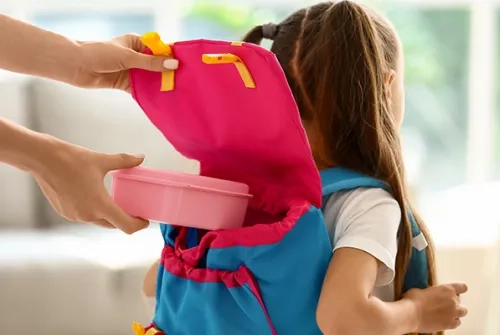Alo Yeditepe
Alo Yeditepe
What is the Right Lunch Box for Children?
Prof. Dr. Hülya Ercan Sarıçoban, Pediatrics and Pediatric Allergy and Immunology Specialist at Yeditepe University Kozyatağı Hospital, made significant statements about what should be in a healthy food box for children going to school.
How to Prepare the Proper Lunch Box?
The contents of the food bag should be determined according to the child's stay at school. For instance, dry or fresh fruit or homemade products may be preferred for children who will only take snacks. However, if you are going to stay in school all day and spend your lunch on the eatables in the food bag, you should definitely set yourself up. At this point, the crucial thing is the necessary needs in the nutrition pyramid. For instance, if a sandwich is to be put, it must contain protein such as cheese, meatballs, and vegetables such as lettuce and tomatoes. At the same time, fiber intake should be supported in order not the child to be constipated. Again, there will be dry or fresh fruit, and buttermilk or kephir will be a good choice.
There should be fruits and vegetables that can be easily washed, cleaned, stored, and consumed by children. For example, carrots, tangerines, bananas, and apples will be the right choices.
Nuts that the child can love such as almonds, chickpeas, raisins, and dates are also very important as they will both give energy and keep you full. It will also be easy to consume. At this point, it will be up to the parents to bring together both the needs of the child and the foods they love.
What Do You Think About School Canteen?
From my own experience, children who know the school has a canteen are not coming to the eating hall. Therefore, they should be allowed to meet with the canteen as late as possible. In fact, I believe that it should definitely not be present in primary schools.
The canteens used by older children should also be very well supervised by the school. Products suitable for the daily nutrition pyramid should be included. Particularly in schools that do not have dining halls, fast food-style products, convenience foods, and packaged products are not feeding our children, but harming them. I believe that parents should both educate children and cooperate with schools on the right choices.
What Products Should the School Canteens Sell?
There should be healthy products that will not spoil as much as possible. Healthy sandwiches, homemade products, kephir, milk, fresh fruit, and nuts can be sold. Even soup can be sold.
Today we are the fattest country in Europe. Weight loss is a major problem in children. The problem of the future is obesity and metabolic diseases. Moreover, in this period when screen exposure increases and children exercise less. It is better to keep children away from unnecessary fatty and high-calorie products. Therefore, we need to start the right eating habit at the age of kindergarten. Whatever the child is accustomed to at a young age, s/he will continue those habits in the future.
Which Foods Should Not Be Put in the Lunch Box?
There should be no pastry for breakfast: In a study, we conducted on this subject, we found that children have a lot of habit of eating pastry for breakfast and when breakfast is mentioned, directly pastry comes to mind. A pastry is definitely not a breakfast. The lack of nutritional value only leads to carbohydrates and fat. It is also not substantial. Hence, pastry products such as savory buns and palm-size buns with or without filling should be avoided for breakfast. If the child wants to eat it so badly, it should be given occasionally, but not very often, or it should be made at home.
Packaged products should not be consumed at any age: No packaged products such as candies, cakes, crackers, or acidic drinks should be given to children at any time of the day. These products have no benefit except that they cause obesity in children due to both the additives they contain and the intense sugar.
Fast food products should be avoided: One of the most significant reasons for unhealthy nutrition and weight gain in children. Furthermore, problems such as attention deficit and allergies are also more common in children who eat these processed foods.
Ready-made fruit juices should not be consumed: We do not recommend fruit juices unless necessary, as they contain a lot of sugar, including those that are said to be natural. Of course, it can be consumed occasionally, but not often. We recommend eating the fruit with pulp. In this way, both less sugar is taken and the need for fiber is met.
How to Feed a Child Without Appetite?
If there is no organic cause, then it is necessary to check between the child and the family relationship. In these children, first of all, mealtimes and durations should be determined. The duration of meals should not exceed 20 minutes. If the child stays at the table longer, you should say, "The meals have worsened in taste, they cannot be eaten anymore". Then, no food should be given to him/her until the next meal. But while doing this, you should not be in an attitude of accusing the child. The aim here is to wait for the child to feel hungry until the next meal, saying that the food is now cold and cannot be eaten. At the next meal, the time should be started by putting the foods that should be eaten in front of them. If the child says ''I am hungry'', you should say; ''The mealtime has not come yet, you must wait.'' When this behavior is insisted on, it will start to improve after a while.
During this time, parents should try not to show that they are angry. Because children can use this situation to attract attention from time to time. They can use it as a reaction or even as a means of self-expression. Hence, parents should be patient. However, there should be no screens, advertisements, or other stimuli when eating. These children can eat better with their peers when they go to school. Eating at school can be a good option in this regard.
About
Faculty and Year of Graduation:
Hacettepe University Faculty of Medicine, 2000
”
See Also
- Is Swallowing Cat Hair Dangerous?
- What is Predisposition to Allergy (Atopy)?
- Allergies in Children Can Increase During the Summer Months
- How to Choose Baby Clothes?
- If Your Child is Constantly Getting Sick in the Winter, It Could be Due to Allergies
- Vaccine Rejection Can Lead to Irreversible Problems!
- Children Whose Parents Are Allergic Are More At Risk
- Pay Attention to the Children Who Get Sick Often
- Allergic Disease Rates Increased from 3% to 15% in the Last 20 Years
- High Fever in Children Article Series I
- Genetics is the Key Cause of Food Allergies in Children
- Pay Attention to Food Allergies in Children!
- Points to Be Considered in Baby Clothing
- What and How Much Should Children Eat at Which Time of Meal?
- Infection Can Cause the Onset of Asthma Disease
Alo Yeditepe





